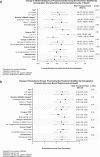Changes in Weight-Related Health Behaviors and Social Determinants of Health among Youth with Overweight/Obesity during the COVID-19 Pandemic
- PMID: 34919458
- PMCID: PMC9492789
- DOI: 10.1089/chi.2021.0196
Changes in Weight-Related Health Behaviors and Social Determinants of Health among Youth with Overweight/Obesity during the COVID-19 Pandemic
Abstract
Objectives: To assess changes in weight-related health behaviors and social determinants of health (SDoH) among youth with overweight/obesity during the coronavirus disease 2019 (COVID-19) pandemic. Methods: We assessed weight-related health behaviors (physical activity, screen time, sleep, and diet) and SDoH (food insecurity, income/childcare, and caregivers' perceived stress) before vs. during the pandemic with a survey administered August-October 2020 to caregivers of 2-17-year olds and adolescents 13-17 years old with BMI ≥85th percentile seen in clinic within 6 months prepandemic. We analyzed changes in continuous variables using paired t-tests and categorical variables with McNemar's or Fisher's exact tests, and the influence of social determinants on behavior change using multivariable regression models. Results: A total of 129 caregivers and 34 adolescents completed surveys. Compared with prepandemic, caregivers reported youth decreased moderate/vigorous physical activity (-87.4 [205.7] minutes/week, p < 0.001) and increased recreational screen time (2.5 [2.1] hours/day, p < 0.001). Fewer had regular bedtimes (before: 89% and during: 44%, p < 0.001) and more ate most meals with television (before: 16% and during: 36%, p < 0.001). Food insecurity increased from 27% to 43% (p < 0.001), 45% reported reduced household income, and caregivers with moderate/high perceived stress scale scores increased from 43% to 64% (p < 0.001). Moderate/high caregiver stress and food insecurity were associated with greater magnitudes of adverse behavior change. Conclusion: Alarming changes in health behaviors among youth with overweight/obesity, particularly among those with stressed caregivers and food insecurity, may increase prevalence of obesity-related comorbidities and exacerbate health disparities. There is an urgent need to expand access to effective interventions for overweight/obesity that address psychosocial stressors.
Keywords: COVID-19 pandemic; obesity; physical activity; screen time; sleep; social determinants of health.
Conflict of interest statement
No competing financial interests exist.
Figures



References
-
- Patrick SW, Henkhaus LE, Zickafoose JS, et al. . Well-being of parents and children during the COVID-19 pandemic: A national survey. Pediatrics 2020;146. - PubMed
-
- Fryar CD. Prevalence of overweight, obesity, and severe obesity among children and adolescents aged 2–19 years: United States, 1963–1965 through 2017–2018. NCHS Health E-Stats 2020. 2020.
Publication types
MeSH terms
Grants and funding
LinkOut - more resources
Full Text Sources
Medical
Research Materials

